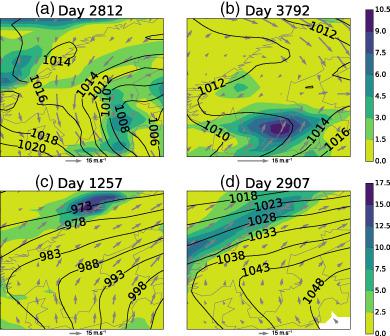当前位置:
X-MOL 学术
›
Int. J. Climatol.
›
论文详情
Our official English website, www.x-mol.net, welcomes your feedback! (Note: you will need to create a separate account there.)
Tailoring circulation type classification outcomes
International Journal of Climatology ( IF 3.9 ) Pub Date : 2021-05-05 , DOI: 10.1002/joc.7171 Felicitas Hansen 1 , Danijel Belušić 1
International Journal of Climatology ( IF 3.9 ) Pub Date : 2021-05-05 , DOI: 10.1002/joc.7171 Felicitas Hansen 1 , Danijel Belušić 1
Affiliation

|
Efforts to intercompare many existing circulation type classification (CTC) methods have found no consistency in their outcomes. Therefore, when confronted with a task to classify atmospheric circulation types, it is difficult to find clear guidelines. This study explores the ways of increasing consistency between existing methods and obtaining physically meaningful and practically useful results. By applying a range of CTC methods to sea-level pressure fields over a Scandinavian domain, it is shown that CTC methods using the same similarity measure (pattern correlation (CORR) or Euclidean distance (DIST)) have higher consistency. It is further shown that CTC outcomes can be tailored towards specific user requirements by properly manipulating the input data. Using unprocessed input data in DIST-based CTC methods frequently results in classes containing physically inconsistent members because the classification procedure is obfuscated by circulation-irrelevant information in the data. Using spatially standardized data in DIST-based methods leads to considerably improved agreement with CORR-based methods and brings high physical consistency within the individual classes. However, standardizing the input data removes too much of the circulation-relevant information and results in no clear improvement in partitioning dependent variables such as precipitation. Best performance is achieved with DIST-based methods using the input data with the spatial mean removed. This simple procedure focuses the CTC methods to use only the circulation-relevant information and hence results both in physically consistent classes and in optimally performing partitioning of dependent variables. Consequently, the recommended guideline would be to use DIST-based methods with spatial-mean-removed input data as the generally most effective classification approach.
中文翻译:

剪裁流通类型分类结果
对许多现有循环类型分类 (CTC) 方法进行比较的努力发现其结果不一致。因此,当面临对大气环流类型进行分类的任务时,很难找到明确的指导方针。本研究探讨了如何提高现有方法之间的一致性并获得物理上有意义且实用的结果。通过将一系列 CTC 方法应用于斯堪的纳维亚域上的海平面压力场,表明使用相同相似性度量(模式相关性 (CORR) 或欧几里德距离 (DIST))的 CTC 方法具有更高的一致性。进一步表明,通过正确处理输入数据,CTC 结果可以针对特定用户需求进行定制。在基于 DIST 的 CTC 方法中使用未处理的输入数据经常导致包含物理上不一致成员的类,因为分类过程被数据中与循环无关的信息混淆。在基于 DIST 的方法中使用空间标准化数据可以大大提高与基于 CORR 的方法的一致性,并在各个类中带来高度的物理一致性。然而,对输入数据进行标准化会去除过多的环流相关信息,并导致在划分因变量(如降水)方面没有明显改善。使用基于 DIST 的方法使用去除空间均值的输入数据实现最佳性能。这个简单的过程将 CTC 方法集中在只使用与循环相关的信息,因此导致物理一致的类和最佳执行因变量分区。因此,推荐的指南是使用基于 DIST 的方法和去除空间均值的输入数据作为通常最有效的分类方法。
更新日期:2021-05-05
中文翻译:

剪裁流通类型分类结果
对许多现有循环类型分类 (CTC) 方法进行比较的努力发现其结果不一致。因此,当面临对大气环流类型进行分类的任务时,很难找到明确的指导方针。本研究探讨了如何提高现有方法之间的一致性并获得物理上有意义且实用的结果。通过将一系列 CTC 方法应用于斯堪的纳维亚域上的海平面压力场,表明使用相同相似性度量(模式相关性 (CORR) 或欧几里德距离 (DIST))的 CTC 方法具有更高的一致性。进一步表明,通过正确处理输入数据,CTC 结果可以针对特定用户需求进行定制。在基于 DIST 的 CTC 方法中使用未处理的输入数据经常导致包含物理上不一致成员的类,因为分类过程被数据中与循环无关的信息混淆。在基于 DIST 的方法中使用空间标准化数据可以大大提高与基于 CORR 的方法的一致性,并在各个类中带来高度的物理一致性。然而,对输入数据进行标准化会去除过多的环流相关信息,并导致在划分因变量(如降水)方面没有明显改善。使用基于 DIST 的方法使用去除空间均值的输入数据实现最佳性能。这个简单的过程将 CTC 方法集中在只使用与循环相关的信息,因此导致物理一致的类和最佳执行因变量分区。因此,推荐的指南是使用基于 DIST 的方法和去除空间均值的输入数据作为通常最有效的分类方法。



























 京公网安备 11010802027423号
京公网安备 11010802027423号